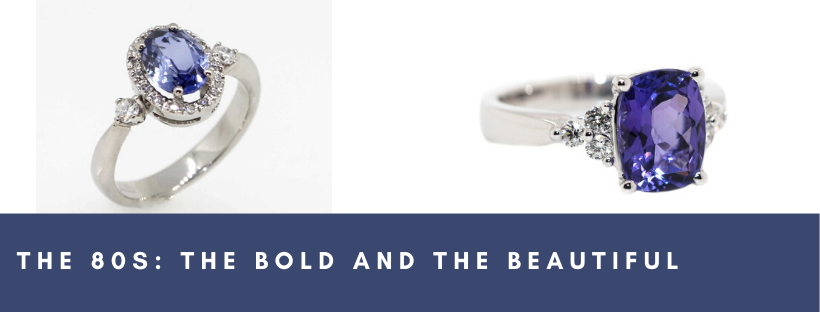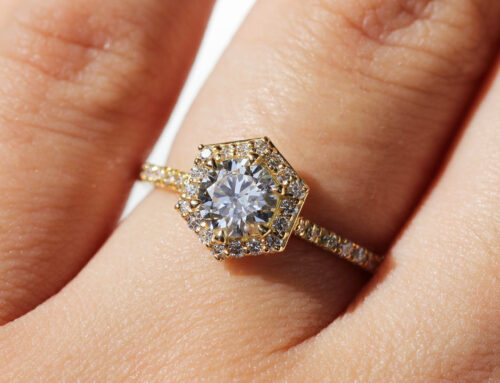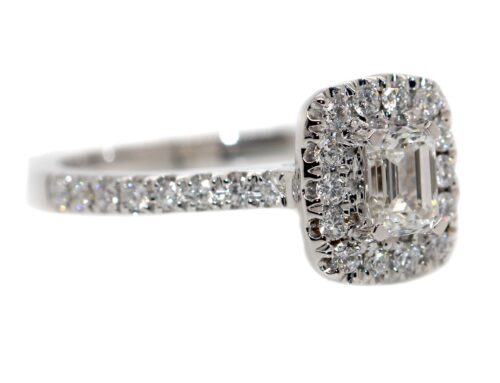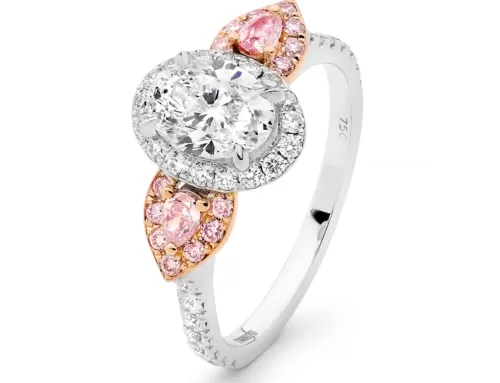Over the last 100 years, trends have come and gone, but some have managed to stand the test of time. Engagement rings saw the rise of the art deco style, trio rings and colourful stones, but the meaning behind an engagement ring hasn’t changed. The durability and preciousness of a diamond represented the serious commitment a couple were agreeing to.

The 20s was the height of the art deco movement. Everything from architecture to homewares to fashion was influenced by the geometric, linear style, including engagement rings. The rings of this era were extravagant, designed with sharp lines and accentuated with diamond halos. Asscher and Emerald-cut diamonds were popular, sometimes emeralds and sapphires were incorporated as well.

The 1930s saw engagement rings evolve from the art deco movement towards the softer more fluid style that would arrive in the 40s. Rings in this decade were designed with a central diamond, often surrounded by swirls or ribbons as the band.

By the time the 40s came around, WWII limited access to platinum so yellow and rose gold rose as the popular metal of choice. Whilst engagement rings were becoming more minimal, the floral and fluid style dominated the 40s. These rings featured a single stone surrounded by the delicate features. De Beers also coined the term “Diamonds are Forever” which led to diamonds being the choice of stone for engagement rings.

The 50s saw a rise in the influence of celebrities. Icons such would receive an engagement ring that would drive a trend towards a similar style. In the 50s, Audrey Hepburn received an engagement ring that featured a trio of bands, introducing stackable rings into the everyday. Stones started getting larger after the war, as well as accessibility to the stones. These would then often be set onto a band in between symmetrical, smaller diamonds or baguettes. This has remained one of the classic engagement ring styles.

Celebrities continued to inspire everyday folk with their own engagement rings. Jackie Kennedy and Elizabeth Taylor received coloured gemstones surrounded by diamonds, inspiring the rise of the colourful gemstone. The 60s also saw a small return of the art deco style, with asscher and emerald-cut diamonds.

The Princess cut was created in the 1970s. More modern style of diamonds were emerging, and with this modernisation, wedding bands were being selected and created to coordinate with engagement rings. Despite these modern styles, the emerald cut diamond remained on-trend and a popular choice for engagement rings.

The 80s was full of vibrant and over-the-top fashion, including rings, which saw the rise of colourful gemstones and fancy cuts. Yellow gold also made a comeback during the 80s. Princess Diana received her iconic sapphire engagement ring from Prince Charles in the 80s. This ring has been replicated and encouraged many to opt for a sapphire for their engagement ring.

The 1990s introduced grunge into the fashion industry, even influencing engagement rings. They were starting to become bold and sharp and more unique. Custom designs became more popular in the 90s, with people wanting to have a unique and special ring. The Marquise-cut was also introduced at this time, reflecting the new style that was emerging.

1960 had made a lasting impression and made an impact on engagement ring styles in the 2000s. This return to tradition welcomed back the 3 stone style, which many chose as it became to represent the past, present and future of the couples relationship. Alternatively, the classic diamond set in a halo was also a popular style in the 2000s.

By the time the 2010s rolled around, the traditional style had settled and evolved into a minimal version. Engagement rings through the 2010s featured thinner bands and the rise of non-diamond stones. Lightly coloured stones such as morganite were popular throughout the years as was moissanite, an alternative to diamonds. The front runner was still a cushion cut set in a halo, but with modern twists such as alternative stones and rose gold bands.

Now we have come full circle and engagement rings have become a statement piece, each one often specially designed for the couple. We can guess that the minimal trend is here to stay, and softer, colourful gems will stay around too. But the 20s may see a return of some of our favourite styles from the last 100 years, including the art deco style and the classic halo and three stone rings. Another trend that we see influencing not only engagement rings, but the jewellery industry in general, is the move towards environmental choices. In the case of engagement rings, more people seek out vintage rings instead of new, but with so many stunning new rings being made this could prove to be a hard trend to follow!







